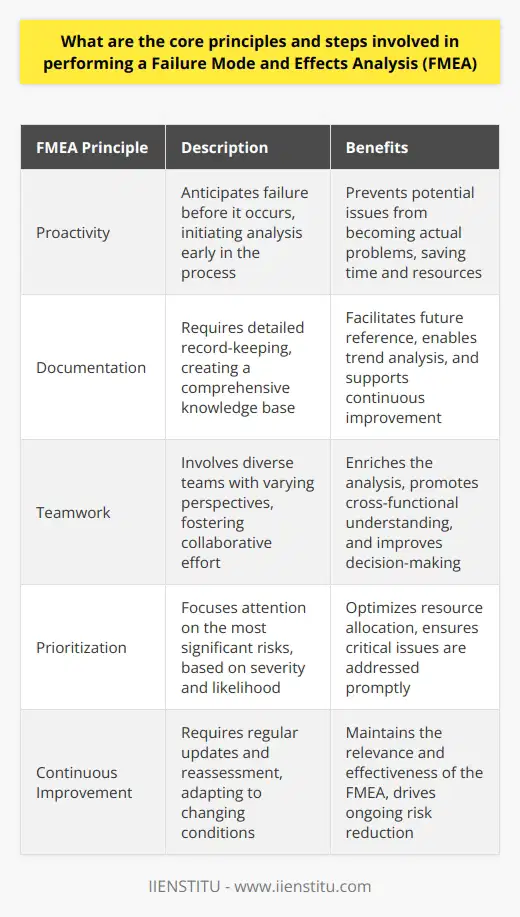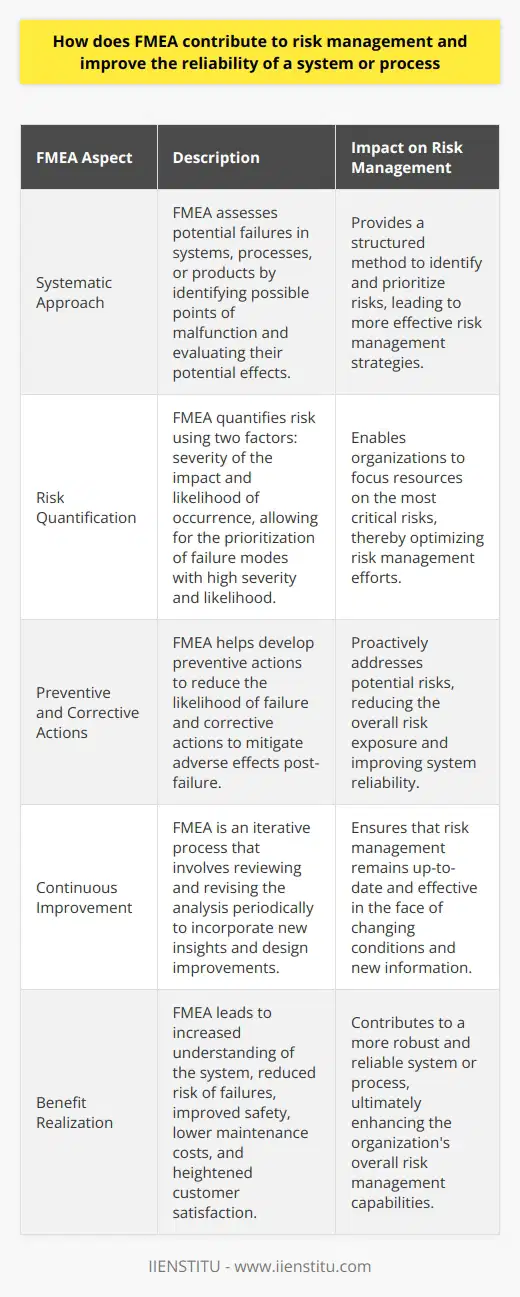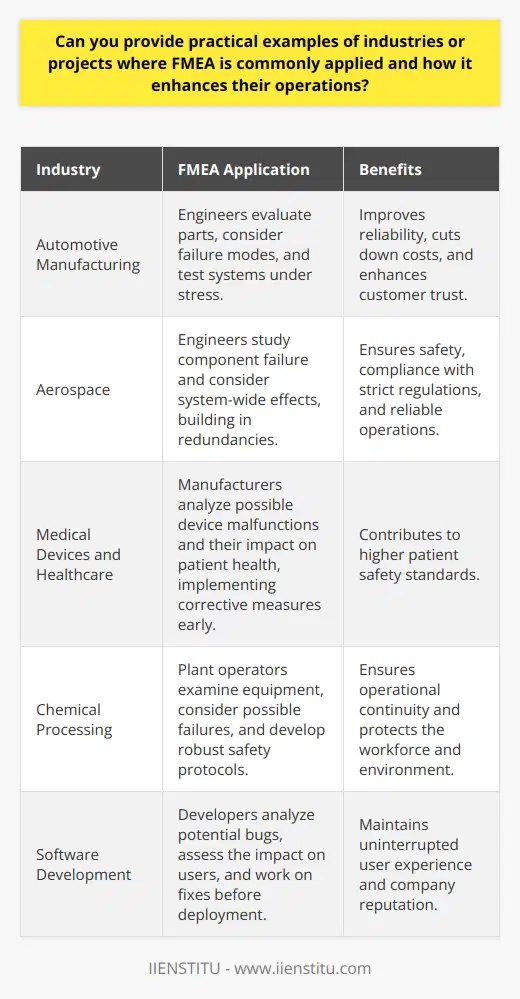
In an increasingly complex and interconnected world, risk management remains a cornerstone of successful business operations. One of the most potent tools in identifying and remedying vulnerabilities within a system or process is Failure Mode and Effects Analysis, commonly known as FMEA.
Designed to determine potential failures before they occur, FMEA offers a structured approach to problem-solving, streamlining operations and ensuring quality control. This guide introduces FMEA to beginners, unfolding its definition, historical development, frameworks, types, and its dual role as both a preventative mechanism and a strategic enhancer in various industries, including but not limited to automotive, aerospace, and healthcare.
How To Develop Problem-solving Skills Through Constant Vocalization
Strategies For Critical Thinking To Challenge Biases And Enhance Decision-making
Introduction to FMEA
Definition of FMEA: Failure Mode and Effects Analysis is a step-by-step approach for identifying all possible failures in a design, a manufacturing or assembly process, or a product or service. It is particularly crucial for system safety, reliability, and quality, focusing on problem areas, their impact on system operations, and the likelihood of failures occurring.
Purpose of FMEA in risk management: The essence of FMEA in risk management lies in its preemptive nature. By analyzing failure modes and their effects on the overall system, stakeholders can prioritize and implement corrective actions that mitigate risk. This approach is in contrast to reactive methods that address faults only after they have manifested.
Importance in contemporary industries: Contemporary industries are adopting FMEA as part of a robust quality assurance strategy. It has become integral in sectors requiring high reliability, like automotive manufacturing, where identifying potential failures can save time, resources, and lives. Similarly, FMEA is used in software development, healthcare, and military applications, demonstrating its versatility and critical role in modern risk management practices.
History of FMEA
Origin and development: FMEA originated in the 1940s, developed by the U.S. military, which sought a systematic tool for reliability engineering. The concept was expanded in the 1960s by NASA and later adopted by the automotive industry, particularly by Ford Motor Company, in response to safety concerns.
Evolution in different fields, e.g., automotive, aerospace, healthcare: From the confines of military applications, FMEA has evolved into a cross-disciplinary methodology. In automotive industries, it became especially important for quality control. Its application further spread to the aerospace sector, where failure can have catastrophic outcomes. In healthcare, FMEA is applied to patient safety, assessing potential errors in medical procedures.
The Conceptual Framework of FMEA
The three key components: Failure Mode, Effects, and Cause: FMEA identifies three key components: the failure mode (the way in which a failure is observed), the effects (the impact of the failure), and the causes (the underlying reason for the failure). Understanding these components helps teams prevent potential failures within their processes and products.
Severity, Occurrence, and Detection – the FMEA risk priority number (RPN): Each failure mode is evaluated based on three metrics: severity, occurrence, and detection. These are used to calculate the risk priority number (RPN), a numerical value that quantifies the risk associated with each failure mode, aiding in the prioritization of mitigation efforts.
Explanation of Severity
Severity evaluates the seriousness of the consequences of failure, detailing the potential impact on the end user or system. A failure mode that poses a risk to human life would score higher in severity compared to one that results in a minor operational issue.
Explanation of Occurrence
Occurrence assesses the frequency at which a failure mode might happen during the lifetime of the process or product. A high occurrence rating implies that a failure mode is more likely to occur, which could indicate a need for process or design improvement.
Explanation of Detection
Detection measures the likelihood of identifying a failure before it transpires or before it becomes critical. This metric accounts for the capability of current controls to detect or prevent the failure mode, thereby influencing the investment in enhancing detection measures.
FMEA procedure: identification, assessment, mitigation and monitoring
The FMEA procedure involves several stages, beginning with the identification of potential failures, followed by the assessment of their impact and likelihood. Next comes the mitigation phase, where strategies to eliminate or reduce the likelihood of the failure are devised and implemented.
Finally, the process includes ongoing monitoring to ensure that the mitigation strategies remain effective.
Types of FMEA
Design FMEA (DFMEA): Design Failure Mode and Effects Analysis focuses on failures related to product design. It aims to anticipate issues that could arise from design flaws before the product is manufactured.
Definition and application of DFMEA: DFMEA systematically examines design reliability and safety by considering potential failure modes based on the design's function. It applies to a variety of design stages, from initial concept to finalized schematics.
Real world example of DFMEA: Real-world examples of DFMEA include assessing the design of an automobile braking system or evaluating a new pharmaceutical compound's design to anticipate adverse reactions before clinical trials.
Process FMEA (PFMEA): Process FMEA, in contrast, targets failure modes associated with manufacturing and assembly processes.
Definition and application of PFMEA: PFMEA systematically evaluates the production process to prevent quality issues and improve efficiency. It helps in identifying processes that have an elevated risk of failure that could affect the final product.
Real world example of PFMEA: An example of PFMEA might involve examining the assembly process of electronic devices to identify steps where components might be improperly installed or damaged, thereby preventing these issues from affecting the final product quality.
Benefits and Limitations of FMEA
Advantages of using FMEA
Adopting FMEA presents several advantages: it enhances a product’s reliability, improves safety, reduces costs associated with failures, and helps meet regulatory compliance. The proactive identification and remediation of potential failure modes can yield significant long-term benefits.
Risk prevention and reduction
The most prominent benefit of FMEA is the prevention and reduction of risks. By forecasting problems and implementing mitigation strategies, the likelihood of failure occurrence and its potential impact are significantly decreased.
Improvement in productivity and efficiency
With FMEA, organizations can streamline their production and design processes by focusing resources on critical failure modes. This focus on proactive risk management can improve overall productivity and efficiency.
Enhancement of customer satisfaction
By ensuring high-quality products and processes, FMEA contributes to improved customer satisfaction. The method helps in building a reputation for reliability and safety, which are key factors in maintaining customer trust.
Drawbacks and challenges of FMEA
Despite its many benefits, FMEA is not without its drawbacks. The complexity of the analysis can make it time-consuming, and the accuracy of the results may be influenced by the knowledge and biases of those conducting the analysis.
Time-consuming process
The thorough nature of FMEA means it can be time-consuming, particularly for complex systems with numerous potential failure modes. This potential drawback requires careful planning and resource allocation.
Potential for subjectivity and bias
FMEA can be subject to subjectivity, as it relies on the judgment of those conducting the analysis to evaluate the severity, occurrence, and detection. This subjectivity can lead to variance in the outcomes and raises the importance of a diverse and knowledgeable team.
Requirement for experienced and trained personnel
To effectively carry out an FMEA and mitigate the potential for bias, it is critical to have experienced personnel with problem-solving training. They provide essential insights that contribute to the robustness of the analysis.
Implementing FMEA in Your Organization
Steps to successful FMEA implementation
Implementing FMEA within an organization requires a systematic and methodical approach. It starts with defining the scope of the analysis and ends with revisiting the FMEA periodically to update it based on new data or changes in processes.
Team composition and roles
For successful FMEA implementation, bringing together a multidisciplinary team that covers different areas of expertise is key. Each member brings unique insights, which is essential for a comprehensive analysis.
Case study on effective FMEA implementation
An organization successfully implementing FMEA might document a case study to share their approach, the challenges they faced, and the benefits realized. Such case studies often serve as benchmarks or guidelines for similar organizations.
The Future of FMEA
Integration with other risk management tools
The integration of FMEA with other risk management tools can increase its effectiveness and provide a more holistic risk assessment. For instance, combining FMEA with root cause analysis (RCA) or Six Sigma can lead to more in-depth insights and broader applications.
Technological advancement and FMEA, such as computational and AI tools
The future of FMEA is influenced by advancements in technology, such as AI and computational tools, which can streamline the assessment process, provide predictive analyses, and more accurately identify potential risks.
Conclusion: The continued relevance of FMEA in risk management
In conclusion, FMEA stands as a critical tool in modern risk management. While there may be challenges in its application, its benefits are substantial, and its adaptive nature suggests it will continue to be relevant across industries as they evolve over time.
Frequently Asked Questions
What are the core principles and steps involved in performing a Failure Mode and Effects Analysis (FMEA)
Understanding FMEA: Core Principles
Failure Mode and Effects Analysis, FMEA, hinges on anticipation. It systematically evaluates potential failure modes. It considers effects on product or process performance. Prioritizing failures by severity forms its crux. FMEA aims for early detection and prevention. It drives reliability improvements. It also fosters clear communication among team members.
Breaking Down the FMEA Steps
Identify the Scope
Define the system, subsystem, or process to analyze. Keep the focus narrow to ensure thoroughness.
Assemble the Team
Collaboration stands central to FMEA. Bring diverse expertise to the team. Engineers, operators, and other stakeholders come together here.
List Potential Failure Modes
Think of ways each component might fail. Use simple, clear language for each mode. Record every possibility without bias.
Determine Effect(s) of Each Failure
Ask what happens after each failure mode. Record the outcomes for each mode. Think about the user and the process.
Assign Severity Ratings
Rate the severity of potential effects. Use a numeric scale, usually 1 to 10. Ten implies severe consequences, one not severe.
Identify Causes of Failures
Find the root causes of each failure mode. This needs careful thought and expertise. Here, the team's expertise proves vital.
Determine Occurrence Ratings
Estimate the probability of each cause. Apply the numeric scale again here. This rating predicts the failing likelihood.
Assess Current Controls
Look at existing prevention and detection measures. Rate their efficacy in controlling failure modes. Strong controls might reduce occurrence ratings.
Assign Detection Ratings
Judge how likely current controls will catch failures. Use the familiar numeric scale. A higher rating means detection is unlikely.
Calculate Risk Priority Numbers (RPN)
Multiply severity, occurrence, and detection ratings. This yields the Risk Priority Number (RPN). A high RPN identifies high-risk areas.
Prioritize Actions
Address high-RPN failure modes as priorities. Lower RPNs can often wait. Resource allocation becomes informed and strategic.
Develop Action Plan
Create strategies to lower high RPNs. This might involve design changes. It could include improved detection controls.
Implement Actions
Carry out the action plans. Apply changes and monitor progress. This stage turns planning into tangible improvement.
Review the Outcomes
After implementing changes, reassess the RPNs. Confirm that the actions have reduced the risk. Document any new risks that emerge.
Core Principles of FMEA
Proactivity
FMEA anticipates failure before it occurs. It does not wait for failure to initiate analysis.
Documentation
FMEA requires detailed record-keeping. It builds a knowledge base for future use.
Teamwork
Diverse teams bring varying perspectives. This collaborative effort enriches the analysis.
Prioritization
Not all failures warrant equal attention. FMEA highlights the most significant risks.
Continuous Improvement
FMEA is not a one-off task. It calls for regular updates and reassessment.
FMEA blends these principles into coherent steps. It serves as a preventive measure for risk management. Embracing FMEA can transform how organizations handle potential failures, making them more resilient and less susceptible to unexpected disruptions.

How does FMEA contribute to risk management and improve the reliability of a system or process
Understanding FMEA
Failure Mode and Effects Analysis (FMEA) is a systematic method. It assesses potential failures in systems, processes, or products. FMEA helps identify possible points of malfunction. It evaluates their potential effects.
FMEA's Role in Risk Management
In risk management, FMEA is a proactive tool. It identifies where and how a system might fail. It also outlines the consequences of such failures. The risk is typically quantified by two factors. Severity of the impact and likelihood of occurrence.
- Severity describes the potential consequence.
- Likelihood refers to the chance of the failure happening.
FMEA pinpoints failure modes with high severity and likelihood. Risk prioritization follows.
Improving System Reliability
FMEA enhances reliability significantly. It identifies failure mode patterns. It helps engineers and managers anticipate problems. They can then undertake preventive measures. These measures correct or diminish the risk.
- Preventive actions reduce the likelihood of failure.
- Corrective actions mitigate adverse effects post-failure.
Steps Involved in FMEA
Define the system. Understand its components and their interconnections.
Identify possible failures. Focus on each part of the system.
Assess risk in terms of severity and likelihood.
Develop action plans. Implement changes to reduce risks.
Review and revise the analysis periodically.
Benefits of FMEA
The benefits of FMEA align with enhanced risk management.
- It increases the understanding of the system.
- It reduces the risk of failures by prioritizing them.
- Improves safety for both users and operators.
- Cuts down maintenance costs by preventing unexpected breakdowns.
- Heightens customer satisfaction through improved reliability.
Conducting FMEA leads to insights. These, in turn, prompt design improvements. It can lead to redundancies in critical areas. This mitigates the effects of potential failures.
In Conclusion
FMEA is integral to risk management. It leads to more robust and reliable systems or processes. It focuses on anticipating what could go wrong. Then it establishes solutions to those problems. FMEA's structured approach is its strength. It results in actionable steps that lead to system improvement. Thus, companies can operate more safely and efficiently.

Can you provide practical examples of industries or projects where FMEA is commonly applied and how it enhances their operations?
Understanding FMEA in Key Industries
Failure Modes and Effects Analysis (FMEA) stands as a proactive tool. Industries use it to foresee potential problems in design, manufacturing, or processes. Analysts map out what might go wrong. They assess the severity. They understand the impact. They devise mitigation strategies.
FMEA in Automotive Manufacturing
Safety is crucial in automotive design. Recalls are expensive. FMEA aids in error detection early. Engineers evaluate parts. They consider failure modes. They test systems under stress. Reliability improves. Costs cut down. Customer trust grows.
Aerospace Applications
Aircraft must perform flawlessly. Stakeholders cannot accept any risk. FMEA helps to ensure safety and compliance with strict regulations. Engineers study component failure. They consider system-wide effects. Redundancies get built in. Reliability forms the core of operations.
Medical Devices and Healthcare
Patient safety is paramount. FMEA assists here. Manufacturers of medical devices apply it rigorously. They analyze the possible device malfunctions. They consider impact on patient health. Corrective measures get implemented early. The process contributes to higher patient safety standards.
Chemical Processing
Chemical plants present multiple hazards. There exists the potential for harmful incidents. FMEA serves as a safety net. Plant operators examine equipment. They consider the possible failures. They develop robust safety protocols. They ensure operational continuity. They protect the workforce and environment.
FMEA in Software Development
Software systems must be reliable. FMEA evaluates software failure modes. Developers analyze potential bugs. They assess the impact on users. They work on fixes before deployment. User experience remains uninterrupted. Companies maintain their reputation.
Conclusion
FMEA proves beneficial across many sectors. It prioritizes prevention. It prepares industries for the unexpected. It enhances operational safety. It protects against financial loss. It ensures customer satisfaction. It fosters a culture of continuous improvement. The practice of FMEA makes operations resilient. It empowers industries to face the future with confidence.



